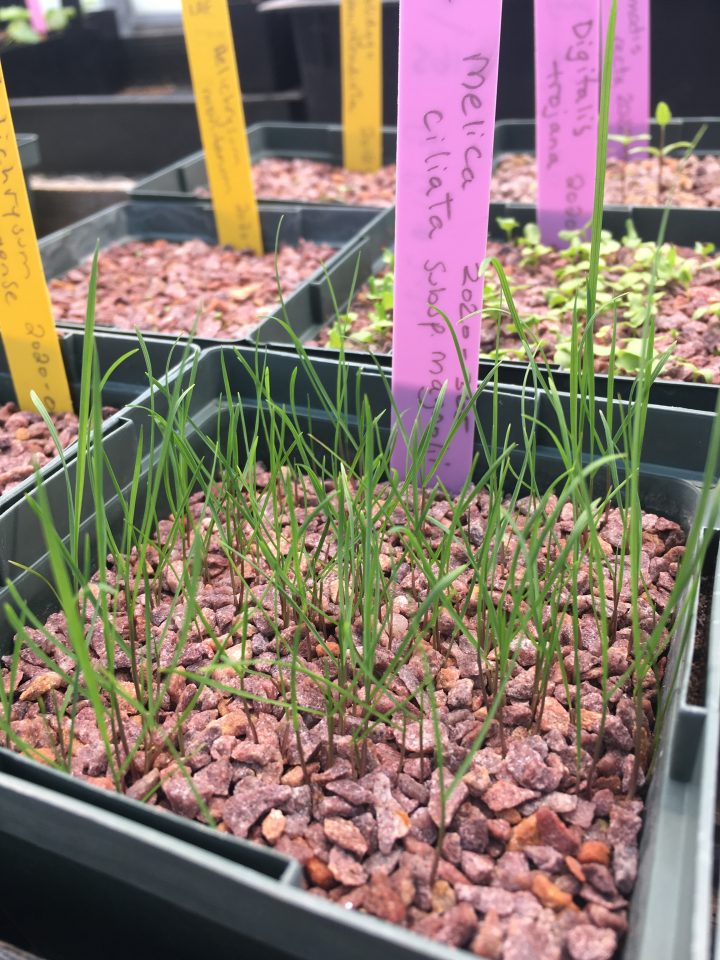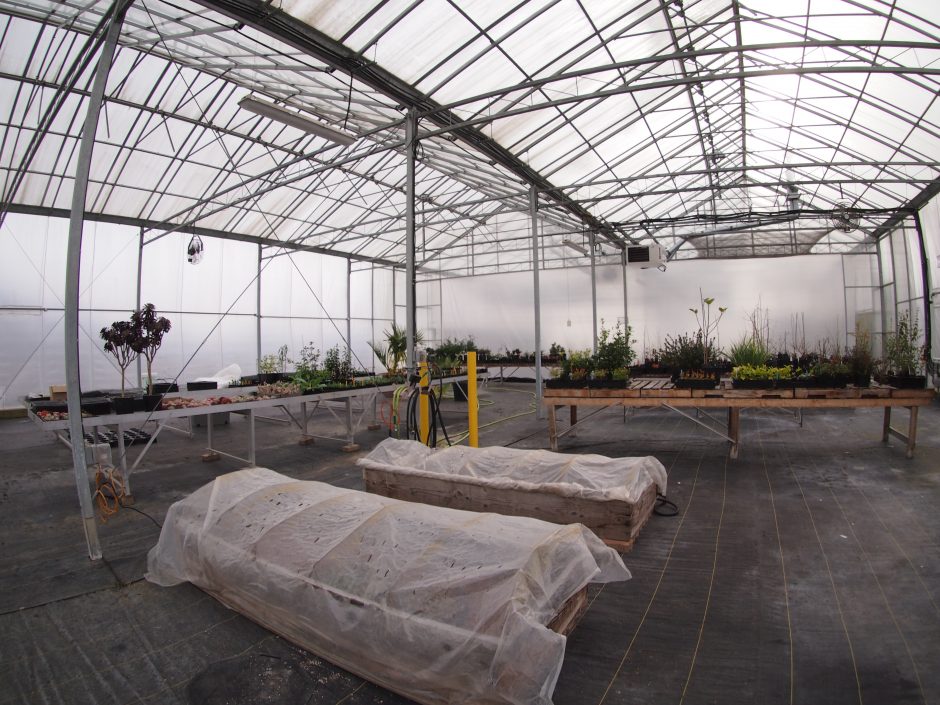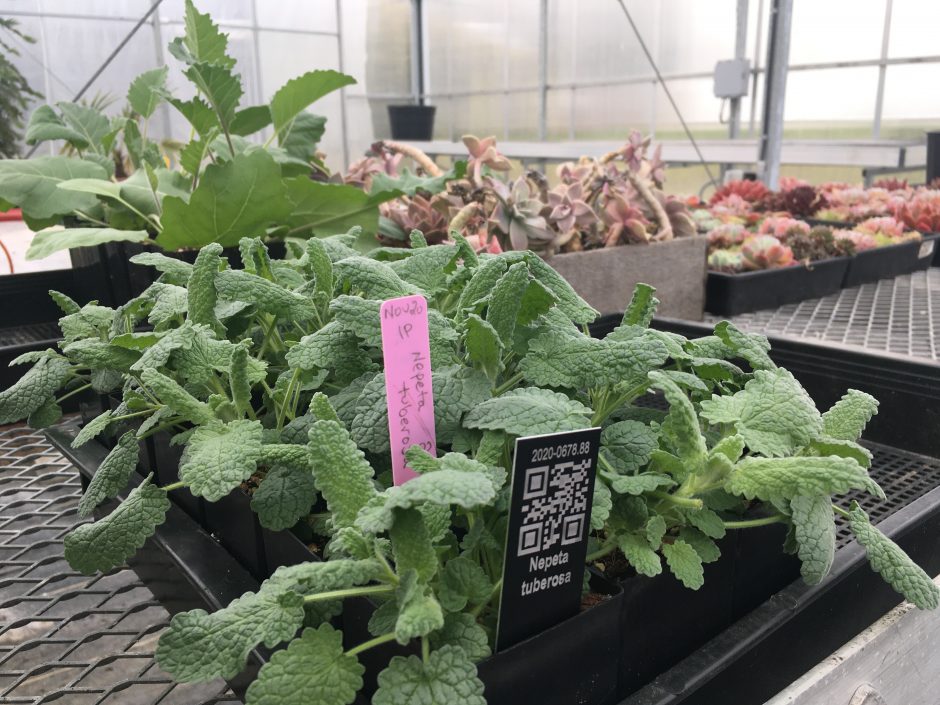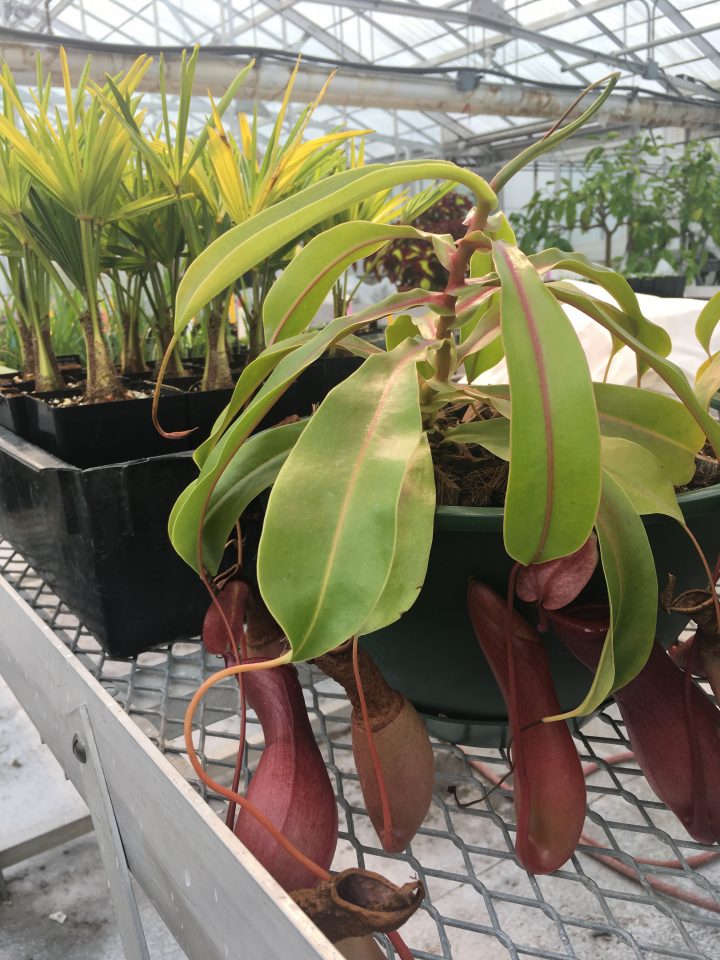“An Education in Propagation” is an ongoing blog post series by Dr. Erin Despard, Artist in Residence at UBC Botanical Garden, exploring the fascinating relationships between people, plants and the methods and technologies used to grow them. Read the Part 1 and Part 3 of this blog post series.
In my previous post I wrote about what I have learned in my explorations of propagation at UBC Botanical Garden to date. In particular, I described how different sites of propagation helped me to see the way plants are embedded in a variety of ecological, social and environmental relationships. In the Garden’s greenhouses on the south end of campus, these relationships are no less in evidence—in fact, perhaps more so, due to their mediation by specialized technologies and architectures.
In a general sense, ‘mediation’ refers to whatever comes between two entities and changes them in some way. A work of art, a process of negotiation, a technology—they all function in basically the same way with respect to the facilitation of relationships. In this entry, I will explore the way greenhouses and other technologies of propagation mediate between plants and environments, and how this can change the way we see both.
In a botanical garden, the need for production greenhouses starts with the fact that the garden’s most important function is the provision of plants for research and learning. This makes it imperative that its plants be identified correctly. Interestingly (for me), correct identification depends in large part on certainty with respect to how a plant was made—or, more precisely, who its parents were. Was it germinated from seed collected from a plant growing in the wild? Cloned from a known specimen? Or is it of garden origin (which means that cross-pollination and therefore hybridization may have occurred)?

Recently germinated seedlings in the (heated) Glasshouse.
The majority of plants growing at UBC Botanical Garden were originally grown from seed collected in the wild by accredited collectors, because this is the most straightforward way to certify their origins. However, given that many seeds will only germinate under specific conditions, some of which are difficult to reproduce in a greenhouse, and/or the climate of the Pacific Northwest, certainty about a plant’s origins depends on the deployment of a range of technologies, in a manner precisely adjusted to the specific needs of different plants.
For example, as the Garden’s Nursery Horticulturist, Kevin Kubeck explained to me, some seeds require a period of exposure to cold temperatures in order to germinate. These are started in an unheated greenhouse whose doors are left open during the winter—a relatively low-tech solution—while others spend time in a refrigerator to provide even colder temperatures. Meanwhile, some seeds require a particular degree of change in temperature to cue germination; these are started in a cold frame with submerged heating wires that can be programmed with a timer to mimic the climatic conditions they would experience in the wild. All of this is carefully documented by Kevin and entered into a database that the Garden’s curators also access. Each plant passes from the greenhouse to the Garden accompanied by an accession number and a series of data entries that not only certify its origins but will guide its future care.

North Production House, with bottom-heated cold frames.

Seedlings in the North Production House.
From this perspective, a visit to the production greenhouses is a good way to see that the plants we encounter in the Botanical Garden are not only presented to us in a cultural (i.e., different from what we find in nature) setting, many of them are also products of a highly artificial environment. Of course, this is not meant as a negative evaluation; it is also not to suggest that the propagation of plants is in any way automated. It is more to point out that technologies such as greenhouses make it possible to see how blurred and porous the boundaries are between what we consider natural and artificial.
While much of Kevin’s time and energy is taken up with monitoring and precisely controlling the conditions he provides for the seeds, cuttings and seedlings under his care, this does not change the fact that he does so within an environment that is only partially sealed off from its surroundings. The greenhouses protect plants from certain elements (particularly wind and cold temperatures) but the air in them needs to exchanged, and they require venting during summer. The way in which Kevin manages the porosity of the greenhouses reveals some important things about their functioning as protective environments, as well as their limitations.
Some of the older propagation manuals I have been reading advise the preventative use of fungicides and pesticides on cuttings and seedlings. However, as Kevin confirmed, this is an increasingly unacceptable practice as awareness grows of the negative environmental impacts associated with these chemicals. He tries to avoid their use wherever possible, but also notes that most of the biological alternatives are prohibitively expensive. Consequently, he employs a variety of strategies to manage problems as they arise—selective use of bacterial control, and hand-picking of weeds and pests, for example. He is also attuned to the way particular technological aids can cause problems. For example, using lights can speed the growth of seedlings but also leads to an increase in certain pests, while misters must be monitored closely to ensure excess humidity doesn’t cause the growth of certain kinds of fungus.

Seedlings in the Glasshouse, along with carnivorous Nepenthes, which help to keep fungus gnats under control.
All in all then, greenhouse growing without the systematic application of pesticides and fungicides, requires a good deal of skilled human tending—not just of plants and pests, but also of technologies. This makes the greenhouse a mediating environment that is not so much managed by, but—because of its porosity—includes the propagator as part of its architecture.
After the forest surrounding the greenhouses was cut down to make way for condos and staff housing, Kevin noticed an increase in the pests he had to manage. The predators that normally keep certain populations in check within the broader environment had declined as the trees disappeared. Which shows us two things: that the greenhouse’s functioning is supported by the health of relationships within its surrounding environment; and that the environment it creates for plants must be continuously cared for by an attentive and—as land development accelerates and funding for botanical gardens becomes more scarce—increasingly hard-working propagator.
It is quite amazing from this perspective, to consider what the majority of plants achieve on their own in the wild, and the myriad of (frequently invisible, sometimes even unknown) relationships that support them in doing so. Amazing, and also—as human activities continue to fragment and degrade natural environments around the world—quite concerning. As the climate changes, how can we replace what plants get from a healthy environment? There is only so much our technologies will allow us to achieve.
Submitted by: Erin Despard, Artist in Residence.
Last fall, UBC Botancial Garden welcomed our new
Artist in Residence, Dr. Erin Despard.
Learn more about Erin’s residency.

Thank you Erin for your informative article regarding “Propagation in the Productive Greenhouse”
It certainly has triggered many challenges our plant species are struggling with, when it comes to our treatment of the environment . We have a lot to learn.
Thank you!